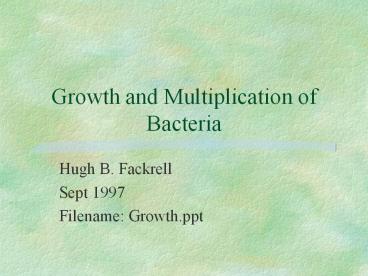Growth and Multiplication of Bacteria - PowerPoint PPT Presentation
Title:
Growth and Multiplication of Bacteria
Description:
Growth and Multiplication of Bacteria Hugh B. Fackrell Sept 1997 Filename: Growth.ppt Requirements for Growth/Multiplication ALL required nutrients correct pH ... – PowerPoint PPT presentation
Number of Views:1255
Avg rating:3.0/5.0
Title: Growth and Multiplication of Bacteria
1
Growth and Multiplication of Bacteria
- Hugh B. Fackrell
- Sept 1997
- Filename Growth.ppt
2
Requirements for Growth/Multiplication
- ALL required nutrients
- correct
- pH
- temperature
- salinity,
- moisture
- redox potential
- atmosphere
3
GrowthLiquid vs Solid Media
- Liquid clear gtgtturbid
- Solid individual colonies
- each colony derived from a single cell
4
Growth Event
- Absorption of water nutrients
- Catabolism of carbon source
- inorganic or organic
- Biosynthesis of new cellular components
- major energy consumption
- Cell enlargement
- Cell division ( Binary Fission)
5
Binary Fission
- DNA replication
- Plasma membrane invaginate
- Cell wall deposited in invaginated space
- Cross wall completed
- Cells separate
6
Binary Fission
- Light micrograph
7
Binary Fission
8
Consequences of Binary Fission
- Very large number of cells very fast
- Mathematical progressions
- arithmetic (1gt2gt4gt6gt8gt10gt12gt14gt16)
- geometric(1gt2gt4gt8gt16)
- exponential expression (20 gt 21 gt 22 gt23gt24)
- logarithmic expression(0 gtlog21gtlog22gtlog23gtlog24
9
Logarithmic Plots
- Can plot very large Range of numbers
- Phases of growth demonstrated
- Generation time easily calculated
10
Cell Multiplication
- 1 20 0 l
- 2 21 log21 ll
- 4 22 log22 llll
- 8 23 log23 lllllllll
- 16 24 log24 lllllllllllllllll
11
Mathematics of bacterial growth
Cells
- Generation Log 2 Log10
- 0 1 0 0.000
- 1 2 1 0.301
- 2 4 2 0.602
- 3 8 3 0.903
- 4 16 4 1.204
- 5 32 5 1.505
- 6 64 6 1.806
- 7 128 7 2.107
- 8 256 8 2.408
12
Growth Data
- Generation cells Log10
- 1 1 0
- 5 32 1.51
- 10 1,024 3.01
- 15 32,768 4.50
- 20 1,048,576 6.02
13
Growth curves for exponentially increasing
population
14
Bacterial Growth Curve
1
5
10
Time (hours)
15
Measurement of Growth Constants
- G Generation Time
- K Mean Growth Rate Constant
G 1/K
16
G Generation time
- Time in minutes or hours for a population of
bacteria to double in number
17
Calculation of Generation Time
Log Number of Bacteria
1
5
10
Time (hours)
18
Slope of Log phase proportional to generation time
Slow
19
K Mean Growth Rate Constant
- K n/t
- K (log10Nt - log10Nt0)/ 0.301t
- N number of cells
- n number of generations
- t time (hr or min)
- K 1/slope ( semi log growth plot)
- Therefore G 1/K
20
Sample calculation for K G
- Population increase from 103 to 109 in 10hrs
- K (log 109 - log 103) / 0.301 x 10
- K 9-3/3.01 2 generations/hours
- G 1/K 1/2 0.5 hr/generation
21
Factors influencing lag phase
- Age of culture inoculum
- old culture -gt long lag
- young culture-gt short lag
- Size of inoculum
- few cells -gt long lag
- many cells -gt short lag
- Environment
- pH, temp, gases,salinity
- sub optimum -gt long lag
- optimum-gt short lag
22
Growth Responses Temperature
10
20
30
40
50
60
-10
0
70
80
90
100
Temperature (o C)
23
Growth Responses pH
3
4
5
6
7
8
1
2
9
10
11
12
pH
24
Diauxic Growth
- Growth on two carbon sources
- Mixed sugars
- Each sugar used separately
- Glucose ALWAYS used first
- Second sugar ONLY used when glucose GONE
25
Diauxic Growth 2 carbon sources
26
Synchronous Growth
- Filtration
- Smaller cells
- all same size
- Temperature shock
- Hot/cold brings cells to same metabolic state
- Starvation
- deplete medium of selected nutrient
27
Synchronous vs Asynchronous growth
28
Growth in Limited Nutrients
- Limiting concentration of Required nutrient
- YIELD
- number of cells
- Linear increase yield with nutrient conc
Yield Mass of organisms formed
Mass of nutrients used
29
Growth in Limited Nutrients
30
Applications of Limiting Nutrient
- Chemostat (continuous culture)
- Bio-Assay
31
Bio-Assay Procedure
- Bacterium CANNOT synthesize nutrient
- Medium all growth requirements except nutrient
to be assayed - Add
- equal amounts of medium to each tube
- equal numbers of bacteria to each tube
- increasing amounts of the nutrient to be assayed
- Unknown
- Incubate
- Measure growth (turbidity or viable count)
32
Bio-Assay
- Vitamin B-12 measurement in Green beans
- Lactobacillus leichmanni
33
Chemostat
- Description of Instrument
- Principle
- Steady State
- Sample Results
- Application
34
Chemostat Description of Instrument
35
Chemostat Principle
- Essential nutrient is limited
- Growth rate(K) controlled by supply rate of
nutrient - Yield controlled by concentration of nutrient
- Dilution rate (D) speed of nutrient flow into
the culture vessel
36
Chemostat Sample Results
37
Chemostat Applications
- Growing large amounts of cells
- Industrial production
- vaccines
- pharmaceuticals
- hormones
- Long term studies of specific growth phase
- Selecting for specific mutants
- Aquatic systems
38
Bacterial Growth in Natural Environments
- Natural Environments
- Animal Tissues
- Soil
- Water- freshwater- marine
- Plants
39
Bacterial Growth in Natural Environments
- Active
- Short bursts of growth metabolism
- usually low rates of growth
- Quiescent
- Viable cannot culture
- Stressed
- starvation semi viable
40
Biofilms Body
- Catheter
- Foley
- latex silicone
- Intravenous
- polyurethane S. epidermidis
- Prostheses
- Hip joints
- Dental implants
- voicebox
- Tampons
- IUD
41
Biofilms Water
- Dental lines
- Spacecraft
- Drinking filters
- ALL surfacces
Biofilm in gut of a mollusc
42
Biofilms Disease
- Cystic fibrosis
- lung-alveolar surface
- Ulcers
- Helicobacter jejuni
- Dental caries
- Streptococccus spp

